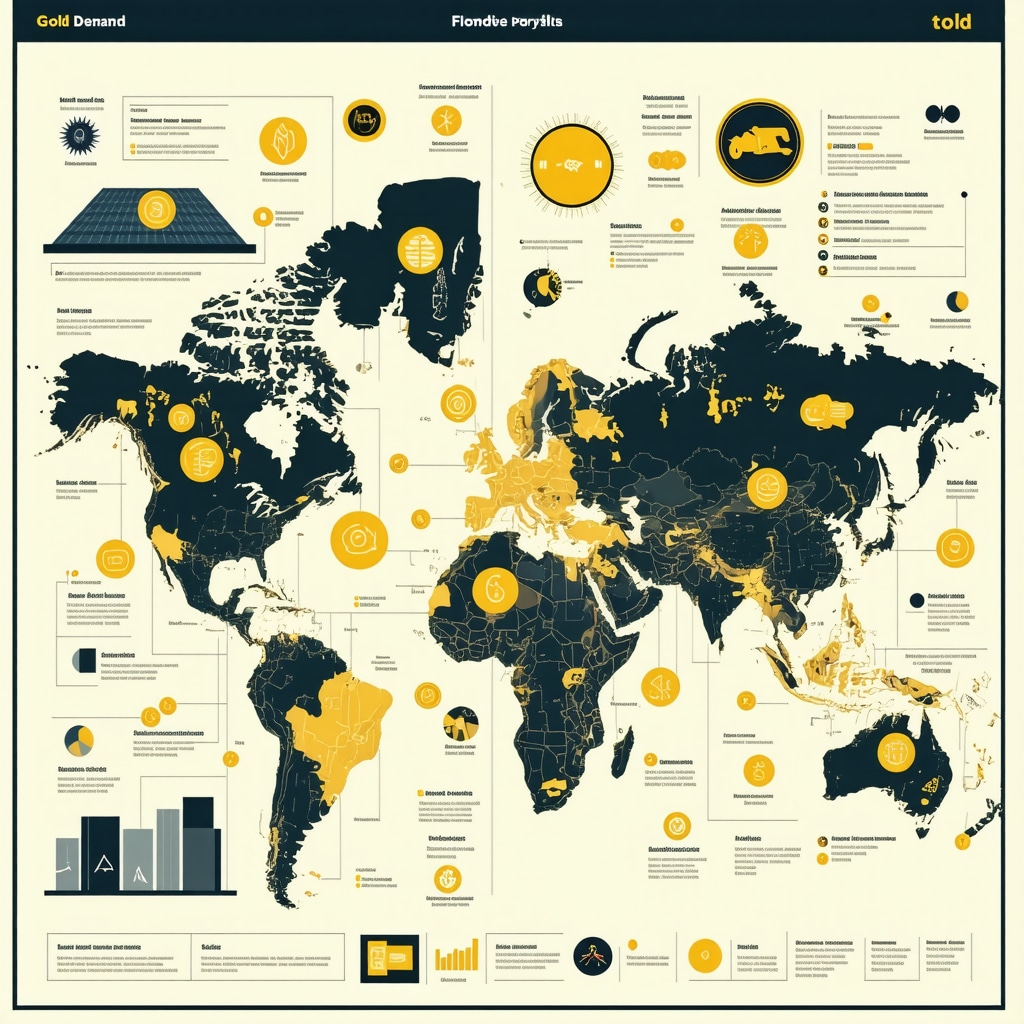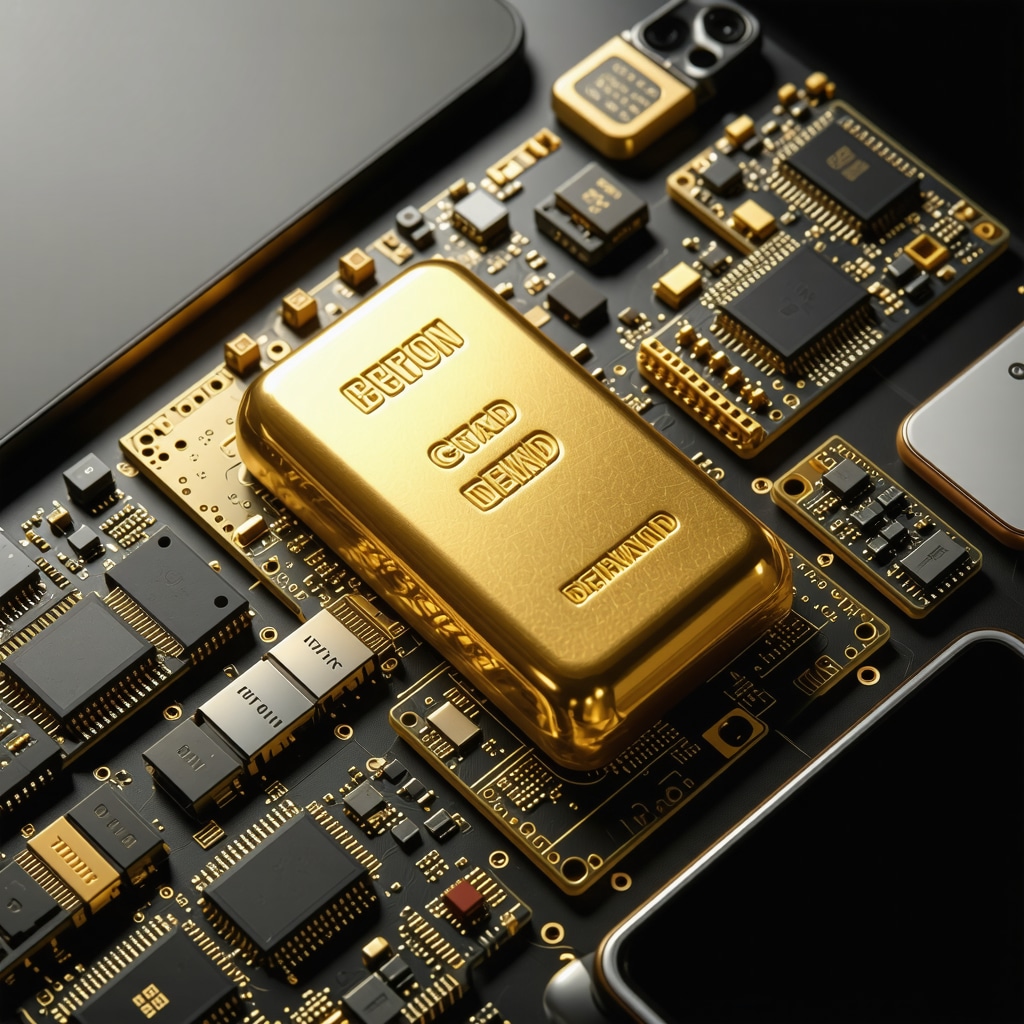Technological Innovation as a Catalyst in Gold Demand Dynamics
The evolution of technology has profoundly influenced global gold demand trends, reshaping traditional consumption patterns and sparking new industrial applications. Beyond its historical role as a store of value and ornamental material, gold today intersects intricately with advanced electronics, medical devices, and emerging high-tech sectors, thereby altering both qualitative and quantitative demand forecasts. This article delves into the multifaceted impact of technology on gold use, highlighting nuanced market forces and future trajectories that sophisticated investors and industry analysts must consider.
From Jewelry to Industry: The Shifting Composition of Gold Demand
Historically dominated by jewelry fabrication, gold demand now increasingly incorporates industrial necessities driven by technological progress. Electronics manufacturing alone accounts for a significant portion of annual gold consumption due to gold’s unparalleled electrical conductivity and corrosion resistance. Innovations in semiconductor design and miniaturized connectors have intensified this demand. Additionally, the medical sector utilizes gold for diagnostic and therapeutic applications such as precision implants and nanotechnology-based drug delivery, underscoring a diversification from conventional markets.
How Does Emerging Technology Reshape Gold Demand Patterns in Industrial Applications?
Emerging technologies like 5G telecommunications, electric vehicles, and renewable energy infrastructure are expanding gold’s industrial footprint. For instance, 5G devices require gold-plated components for reliable high-frequency signal transmission, while electric vehicle batteries integrate gold in sensor systems to enhance performance and longevity. Moreover, photovoltaic cells in solar panels increasingly incorporate gold to optimize efficiency. These developments suggest a sustained upward trajectory in industrial gold demand, potentially counterbalancing fluctuations in traditional consumption sectors.
Analytical Perspectives on Market Implications and Investment Strategies
Understanding the technological drivers behind gold demand is essential for forecasting price movements and crafting robust investment strategies. The integration of gold in cutting-edge technologies introduces new demand elasticity factors, requiring investors to monitor sector-specific innovations and supply chain dynamics closely. For strategic allocation, referencing comprehensive analyses such as this detailed gold demand trends report provides critical insights into how industrial and consumer needs interplay in shaping market behavior.
Technological Advancements and Their Influence on Gold Supply Constraints
While demand evolves, technology also impacts gold supply through enhanced mining techniques and recycling processes. Advanced extraction technologies improve yield efficiency, mitigating scarcity risks. Concurrently, sophisticated recycling methods reclaim gold from electronic waste, contributing to supply-side resilience. However, the rapid pace of technological adoption could exacerbate short-term supply deficits, influencing price volatility and necessitating vigilant market analysis.
Engage with Leading Gold Market Thought Leaders
For professionals seeking to deepen their understanding of gold’s intersection with technology and market trends, engaging with expert communities and exploring advanced resources is invaluable. Visit our comprehensive guide on gold demand trends and market effects to expand your knowledge and contribute your insights to ongoing discussions shaping this dynamic field.
According to the World Gold Council, industrial applications have steadily increased their share of gold demand, emphasizing the metal’s critical role beyond traditional investment and jewelry markets (World Gold Council – Gold Demand Trends).
Technological Evolution Driving Gold Recycling and Sustainable Supply Chains
As technology advances, the gold supply landscape is increasingly shaped by innovative recycling methods and sustainable practices. Urban mining, or the recovery of gold from electronic waste, has become a critical component in meeting the rising industrial demand. State-of-the-art chemical processes and automated sorting technologies enable efficient extraction of gold from discarded devices, reducing reliance on traditional mining and mitigating environmental impact. This dual approach not only supports supply resilience but also aligns with global sustainability goals.
Decoding Investor Strategies Amidst Technology-Influenced Gold Market Shifts
Investors must adapt to the nuanced interplay between technological trends and gold market dynamics. Incorporating technological innovation insights into investment frameworks can unveil emerging opportunities and risks. For instance, sectors like electronics and renewable energy may drive incremental demand that influences price trajectories differently than conventional gold investment factors. Strategic diversification across physical gold, ETFs, and technology-linked mining stocks can optimize portfolio resilience.
What Advanced Analytical Tools Can Investors Use to Quantify Technology-Driven Gold Demand?
To navigate the complexity of technology’s role in gold markets, investors increasingly turn to data-driven models and real-time analytics. Tools leveraging artificial intelligence and machine learning analyze supply chain disruptions, patent filings, and sectoral growth patterns to forecast demand shifts accurately. Incorporating macroeconomic indicators alongside technological adoption rates allows for more precise gold price predictions and investment timing. Utilizing such sophisticated analytics aligns with best practices recommended by financial authorities and industry research bodies.
According to a comprehensive study by the World Gold Council, integrating technological demand metrics into gold market analysis enhances forecasting accuracy and investment decision-making (World Gold Council – Gold Demand Trends).
Balancing Physical and Paper Gold: A Strategic Imperative in a Tech-Driven Market
Given the evolving gold demand landscape influenced by technology, investors face critical choices between physical gold holdings and paper gold instruments such as ETFs and mutual funds. Physical gold offers tangible security and protection against systemic risks, whereas gold ETFs provide liquidity and exposure aligned with market sentiment and industrial demand fluctuations. Crafting a balanced portfolio that incorporates both forms can harness the benefits of technological demand growth while managing volatility effectively. For detailed guidance on portfolio construction, consult our in-depth resource on building a balanced gold ETF portfolio.
Technological Risks and Opportunities: Navigating Supply Chain Vulnerabilities
The gold supply chain is increasingly susceptible to technological disruptions, including cyber threats and geopolitical tensions impacting mining operations and transportation. Advanced analytics not only help in demand forecasting but also in identifying vulnerabilities that could affect supply stability. Investors and industry stakeholders must consider these risks when evaluating gold investment strategies, as sudden supply shocks can trigger significant price volatility. Proactive risk management leveraging technology-driven insights becomes indispensable in this context.
Join the Conversation on Technology’s Transformative Impact on Gold Markets
We invite market professionals and enthusiasts to share their perspectives on how technological innovation is reshaping gold demand and supply. Engage with our community by commenting below and explore our extensive repository of expert analyses, including the gold demand trends report to stay ahead in this dynamic landscape. Sharing your insights enhances collective understanding and supports informed investment decisions.

Unveiling the Role of AI and Blockchain in Optimizing Gold Market Efficiency
The intersection of artificial intelligence (AI) and blockchain technology is poised to transform gold market operations profoundly. AI-driven predictive analytics enable stakeholders to anticipate demand fluctuations with unprecedented accuracy by processing vast datasets encompassing geopolitical events, technological adoption rates, and supply chain disruptions. Meanwhile, blockchain facilitates transparent and immutable tracking of gold provenance, enhancing trustworthiness and reducing counterfeiting risks in physical gold transactions. Together, these technologies foster a more resilient, efficient, and transparent gold ecosystem, aligning with the increasing complexity introduced by technological demand factors.
How Can Blockchain Technology Mitigate Fraud and Enhance Traceability in Gold Supply Chains?
Blockchain implementation in gold supply chains offers a decentralized ledger system that records every transaction from mine to market. This immutable record combats fraud by preventing unauthorized alterations and providing verifiable proof of origin, which is critical given the rising concerns over conflict gold and unethical mining practices. By integrating smart contracts, stakeholders can automate compliance verification and payments, minimizing delays and human errors. For example, Tracr, the De Beers-backed platform, exemplifies how blockchain delivers end-to-end transparency, thus fostering ethical sourcing and investor confidence.
Advanced AI-Driven Forecasting Models: Navigating Complexity in Gold Demand Projections
Traditional forecasting methods face limitations amid the multifaceted technological influences reshaping gold consumption. Advanced AI models leverage machine learning algorithms trained on historical and real-time data, including patent activity, industrial output, and global economic indicators, to generate nuanced demand forecasts. These models adapt dynamically to emerging trends like quantum computing’s potential impact on electronics and gold usage. The continuous refinement of these predictive tools supports more informed decision-making for miners, manufacturers, and investors, optimizing resource allocation and risk mitigation.
Integrating Sustainable Mining Technologies with Circular Economy Principles
Emerging sustainable mining technologies, such as bioleaching and robotics-assisted excavation, are redefining environmental stewardship in gold production. Bioleaching utilizes microorganisms to extract gold at lower energy costs and reduced chemical usage, mitigating ecological footprints. Robotics enhance operational precision and safety in hazardous mining environments. Coupling these innovations with circular economy principles—prioritizing recycling, reuse, and waste minimization—establishes a holistic approach to sustainable gold supply. This synergy not only addresses regulatory pressures but also appeals to environmentally conscious investors, influencing market demand patterns.
Strategic Implications for Portfolio Diversification in a Tech-Infused Gold Market
As gold demand becomes increasingly tethered to technological innovation, portfolio diversification strategies must evolve accordingly. Investors should consider exposure to technology-driven mining companies leveraging AI and blockchain, alongside conventional physical gold holdings and ETFs. Incorporating thematic funds focused on sustainable and ethical gold mining can further align investment objectives with emerging market values. Such a multi-faceted approach mitigates sector-specific risks while capitalizing on growth opportunities stemming from the converging technology and precious metals sectors.
Exploring the Nexus Between Quantum Computing and Future Gold Use Cases
Quantum computing, still in nascent stages, promises revolutionary breakthroughs in material science and electronics, potentially catalyzing novel applications for gold. Gold’s exceptional conductivity and stability may position it as a critical component in quantum processors or quantum sensor technologies. Anticipating these developments requires interdisciplinary expertise and continuous monitoring of research advancements. Consequently, gold demand forecasts must integrate scenarios accounting for such disruptive technologies, which could trigger paradigm shifts in industrial consumption.
What Are the Potential Risks of Technological Displacement Affecting Gold Demand?
While technology drives new demand avenues, it also harbors the risk of displacement. For instance, the advent of graphene and other novel conductive materials may substitute gold in certain applications due to cost or performance advantages. Similarly, advancements in digital assets and blockchain might reduce reliance on physical gold as a store of value. Therefore, investors and industry analysts must critically evaluate these countervailing forces, leveraging scenario analysis and stress testing to navigate uncertainty.
Leading research from the World Gold Council underscores the necessity of incorporating technological innovation metrics into comprehensive market assessments to maintain strategic agility in evolving gold markets.
Invitation to Engage: Advancing the Dialogue on Technology and Gold Market Evolution
We encourage market professionals, technologists, and investors to deepen their engagement with these transformative themes. Sharing insights, case studies, and emerging research fosters a collaborative environment that enhances collective understanding. Explore our curated expert analyses and contribute your perspectives by visiting our detailed resource on gold demand trends in the context of technological innovation. Together, we can navigate the complexities and unlock the potential of gold’s evolving role in a technology-driven world.
Unlocking the Synergy Between AI-Powered Analytics and Gold Market Intelligence
The fusion of artificial intelligence with traditional market analysis has ushered in a paradigm where predictive accuracy in gold demand forecasting achieves unprecedented precision. By assimilating heterogeneous datasets—ranging from patent filings and global supply chain telemetry to macroeconomic stress signals—AI models dynamically recalibrate forecasts in response to real-time technological disruptions. This strategic integration empowers stakeholders to anticipate emerging consumption patterns, particularly within nascent sectors like quantum computing and advanced electronics, thereby refining investment timing and resource deployment strategies.
Blockchain’s Role in Fortifying Ethical Sourcing and Supply Chain Transparency
Beyond fraud mitigation, blockchain technology enables a granular traceability framework that elevates stakeholder confidence by ensuring verifiable provenance and compliance with international ethical mining standards. Platforms such as Tracr exemplify end-to-end transparency, utilizing smart contracts to automate compliance audits and facilitate instantaneous transaction settlements. This technological infusion not only mitigates reputational risks but also aligns gold markets with global sustainability mandates increasingly demanded by institutional investors.
How Are Cutting-Edge Recycling Innovations Reshaping Gold Supply Dynamics Amidst Rising Demand?
Innovations in urban mining—employing advanced chemical leaching, AI-driven sorting, and robotics-enhanced extraction—are materially enhancing the recovery rates of gold from electronic waste streams. These advances mitigate traditional mining bottlenecks and environmental impacts, offering a sustainable supply augmentation that is crucial in balancing surging industrial consumption fueled by 5G and renewable energy sectors. Integration of circular economy principles further optimizes resource efficiency, positioning recycled gold as a pivotal component within the global supply chain resilience framework.
For authoritative insights, the World Gold Council’s Gold Demand Trends report provides comprehensive data and analysis on how these technological and sustainable supply shifts affect market dynamics.
Strategic Portfolio Construction: Leveraging Technological Trends to Optimize Gold Investment Returns
In an environment where technological disruption continuously redefines gold usage, investors must adopt multi-dimensional allocation strategies. This includes integrating exposure to mining companies pioneering AI and blockchain applications, thematic ETFs focused on sustainable mining, and physical gold holdings for systemic risk hedging. Advanced scenario modeling incorporating technological displacement risks—such as alternative conductive materials and evolving digital asset frameworks—enables proactive portfolio adjustments that safeguard against volatility while capitalizing on emergent growth vectors.
Emerging Frontiers: Quantum Computing’s Potential to Revolutionize Gold Utilization
The prospective integration of gold components in quantum computing hardware and sensor arrays underscores an untapped demand frontier. Anticipating these paradigm shifts necessitates interdisciplinary collaboration between technologists, material scientists, and market analysts to accurately embed such scenarios into long-term demand projections. This foresight is essential to preemptively adjust supply chain strategies and investment postures in alignment with disruptive technology trajectories.
Mitigating Supply Chain Vulnerabilities Through Tech-Enabled Risk Management
The increasing complexity and interconnectivity of gold supply chains demand sophisticated risk mitigation frameworks. AI-powered anomaly detection and blockchain-enabled provenance verification collectively enhance resilience against cyber intrusions, geopolitical disruptions, and logistical bottlenecks. These integrated solutions afford market participants early warning signals and actionable intelligence, fostering adaptive strategies that preserve supply stability and market confidence.
Invitation to Collaborate: Engage with Experts at the Intersection of Technology and Gold Markets
We encourage thought leaders, technologists, and investors to deepen their engagement with these advanced themes. Contribute your research, share case studies, and participate in shaping strategic dialogues by accessing our in-depth analyses on gold demand trends influenced by technological innovation. Your expertise enriches collective intelligence, empowering the community to navigate the evolving complexities of gold markets effectively.

Expert Insights & Advanced Considerations
The Synergistic Role of AI and Blockchain in Enhancing Gold Market Transparency
Artificial intelligence and blockchain technologies are not merely incremental tools but foundational enablers that reshape gold market operations. AI’s predictive analytics refine demand forecasting by assimilating complex datasets, while blockchain ensures immutable provenance verification, curbing fraud and uplifting ethical sourcing standards. This synergy is pivotal for stakeholders aiming to navigate an increasingly complex, tech-driven gold ecosystem with confidence.
Quantum Computing as a Frontier Driver of Future Gold Consumption
Although nascent, quantum computing heralds a paradigm shift with potential to significantly increase gold’s industrial demand. Gold’s superior electrical properties position it as a candidate material in quantum processors and sensors. Investors and analysts must incorporate scenario analyses of quantum technology adoption to anticipate and capitalize on these emerging, high-impact use cases.
Advanced Recycling Technologies Bolstering Sustainable Gold Supply Chains
Innovations in urban mining—using AI-enhanced sorting, robotics, and chemical leaching—are revolutionizing gold recycling from electronic waste. This mitigates environmental impacts and reduces supply-side volatility, aligning with circular economy principles. Such sustainable practices are becoming essential components of supply resilience amid rising industrial demand from sectors like 5G and renewable energy.
Strategic Portfolio Diversification in a Technology-Infused Gold Market
Given the multifaceted influences of technological innovation, a nuanced portfolio approach is imperative. Integrating physical gold with thematic ETFs focused on tech-driven mining and sustainable practices, alongside selective mining stocks employing AI and blockchain, balances risk and captures growth. Incorporating scenario modeling for technological displacement risks further fortifies investment resilience.
Mitigating Supply Chain Vulnerabilities Through Tech-Enabled Risk Management
The increasing complexity of global gold supply chains demands sophisticated risk frameworks. AI-powered anomaly detection combined with blockchain-enabled traceability provides early warnings of disruptions, from cyber threats to geopolitical tensions. Proactive leveraging of these technologies helps maintain supply stability and market confidence.
Curated Expert Resources
- World Gold Council – Gold Demand Trends: Offers comprehensive, data-rich analyses on global gold consumption patterns, integrating technological and industrial demand factors essential for expert market assessment.
- Tracr Blockchain Platform: Demonstrates practical blockchain application in gold provenance and ethical sourcing, serving as a benchmark for transparency and compliance in supply chains.
- BuyingGoldNow.com – Understanding Gold Demand Trends: Provides in-depth exploration of the interplay between jewelry, industrial uses, and technological innovation shaping gold markets, valuable for sophisticated investors.
- BuyingGoldNow.com – How to Build a Balanced Gold ETF Portfolio for Growth in 2025: A resource guiding strategic portfolio construction that integrates technological demand drivers and sustainable investment themes.
- World Bank and UN Reports on Sustainable Mining Technologies: Contextualize environmental and operational advances relevant to gold supply sustainability and circular economy integration.
Final Expert Perspective
Technological innovation is fundamentally reshaping the dynamics of gold demand and supply, introducing both unprecedented opportunities and complex challenges. From AI-driven forecasting to blockchain-enabled supply chain integrity, and from quantum computing’s prospective industrial applications to advanced recycling methodologies, gold’s role is evolving beyond traditional paradigms. Expert stakeholders must adopt multidimensional strategies that incorporate these technological vectors to maintain strategic agility and capitalize on emergent growth avenues. For those intent on mastering this evolving landscape, engaging deeply with authoritative analyses and integrating technology-informed insights into investment frameworks is not optional but imperative. We invite you to further explore these themes through our comprehensive resources and contribute your expert perspectives, advancing the collective understanding of gold’s transformative journey in a technology-driven world.
Explore more on building resilient portfolios in this context at BuyingGoldNow’s guide to balanced gold ETF portfolios and deepen your strategic approach to gold investments amidst technological shifts.










